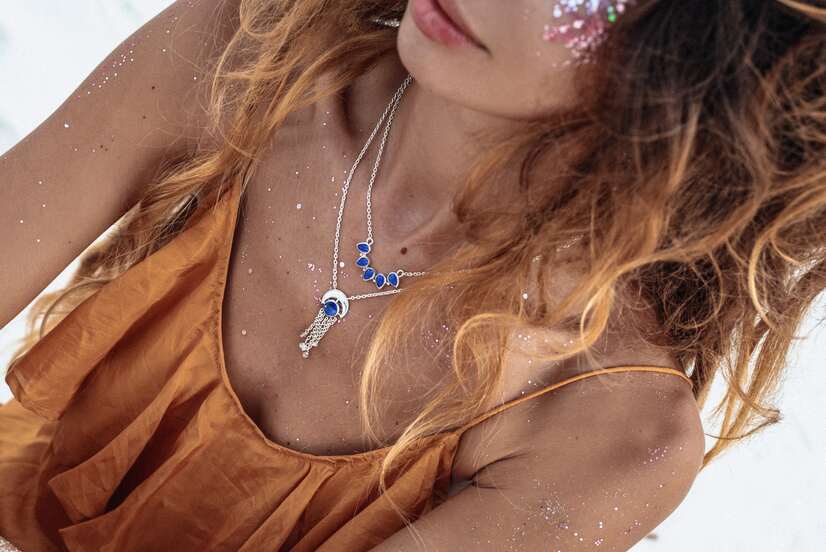Over the entire course of time, gemstones have held huge worth, both for their tasteful allure and their symbolic implications. Among these, kyanite — a striking blue gemstone — has enthralled the consideration of different ancient civic establishments. This article dives into the history of kyanite jewelry, exploring how this momentous mineral was utilized and worshipped across various cultures. We will likewise examine the job of kyanite rings in ancient times and how they have developed into the delightful pieces we see today.
The Origins of Kyanite
Kyanite is an aluminosilicate mineral that structures in transformative rocks, ordinarily under high tension and low temperature conditions. Its name is gotten from the Greek word “kyanos,” signifying “blue,” which mirrors the gemstone’s most normal and striking tone. Be that as it may, kyanite can likewise show up in shades of green, dark, and, surprisingly, lackluster, contingent upon the pollutions present during its development.
The mineral was first distinguished in the eighteenth 100 years, however proof proposes that ancient developments knew about its presence some time before it was formally acknowledged by current mineralogists. Kyanite’s remarkable properties, like its unmistakable pleochroism (the capacity to show various varieties when seen from various points), made it a gemstone of incredible interest and worth.
Kyanite in Ancient Developments
Ancient Egypt
Ancient Egypt is prestigious for its rich utilization of gemstones in both individual embellishment and strict practices. While kyanite was not generally so usually utilized as lapis lazuli or turquoise, it actually held a unique spot in Egyptian culture. Kyanite jewelry, especially kyanite rings, were viewed as symbols of protection and strength. The dark blue shade of kyanite was related with the Nile Stream and the sky, the two of which were integral to Egyptian folklore.
Kyanite was additionally accepted to have healing properties. Egyptian clerics would frequently wear kyanite rings during customs, accepting that the stone could channel divine energy and give spiritual protection. The stone’s association with the divine beings made it a respected material, frequently utilized in special necklaces and other defensive charms.
Ancient Greece and Rome
In ancient Greece, kyanite was esteemed for its likeness to the sapphire, one more blue gemstone that was exceptionally valued for its excellence and assumed defensive powers. Greek troopers would frequently convey kyanite jewelry, especially rings, into fight as a charm to avoid hurt. The Greeks accepted that kyanite could give safe entry through perilous landscapes, especially while going via ocean.
The Romans, known for their affection for intricate jewelry, additionally integrated kyanite into their designs. Kyanite rings were many times set in gold and worn by all kinds of people of high status. The gemstone was accepted to have the ability to quiet attitudes and advance serenity, pursuing it a famous decision for those in, important, influential places. Moreover, Roman craftsmans valued kyanite for its flexibility in cutting, which permitted them to make complex designs and settings.
The Indian Subcontinent
In ancient India, gemstones assumed a critical part in both strict and public activity. Kyanite, known as “disthene” in certain areas, was accepted to adjust energy and advance inward harmony. Kyanite jewelry, especially as rings and necklaces, was worn by yogis and spiritual pioneers to support contemplation and interface with the heavenly.
The stone’s blue tone was additionally connected with the throat chakra. Or “Vishuddha,” which is accepted to oversee correspondence and self-articulation. Wearing kyanite rings was remembered to upgrade one’s capacity to talk honestly and without hesitation, a quality exceptionally esteemed in Indian culture. The gemstone was likewise utilized in traditional Ayurvedic medication. Where it was accepted to help adjust the chakras and advance generally speaking prosperity.
The Advancement of Kyanite Jewelry
As shipping lanes extended and cultures started to cooperate all the more every now and again. The utilization of kyanite in jewelry spread to different regions of the planet. During the Medieval times, kyanite was utilized in European jewelry, in spite of the fact that it was frequently confused with other blue gemstones, like sapphire or blue tourmaline. The gemstone’s generally low hardness made it more uncommon in rings. However it was as yet appreciated for its novel tone and pleochroism.
In later history, kyanite has encountered a resurgence in prevalence, especially in the twentieth and 21st hundreds of years. Propels in gemstone cutting and jewelry design have permitted kyanite to be all the more generally utilized in rings. Necklaces, and different types of embellishment. Present day gemologists have likewise fostered a more profound comprehension of kyanite’s properties. Permitting them to more readily recognize it from other comparable gemstones.
Kyanite Rings in Current Times
Today, kyanite rings are valued for their excellence and exceptional properties. The gemstone’s dark blue tone, frequently contrasted with that of the best sapphires. Settles on it a famous decision for those looking for an unmistakable and rich piece of jewelry. Kyanite rings are many times set in silver or white gold to supplement the stone’s cool tones. Albeit yellow gold settings are likewise normal.
Notwithstanding its stylish allure, kyanite is as yet accepted to have metaphysical properties. Many individuals wear kyanite rings as a type of spiritual protection or to support contemplation and correspondence. The gemstone’s association with the throat chakra keeps on being a critical part of its cutting edge request.
End
The history of kyanite jewelry is a demonstration of the enduring charm of this novel gemstone. From its utilization in ancient Egyptian ornaments to its current prevalence in rings and necklaces. Kyanite has caught the creative mind of individuals across cultures and time spans. Whether esteemed for its magnificence, its symbolic implications, or its alleged metaphysical properties. Kyanite stays a gemstone of critical historical and cultural importance. As we proceed to investigate and value the tradition of ancient kyanite jewelry. We gain a more profound comprehension of the manners by which gemstones have formed mankind’s history and culture.

